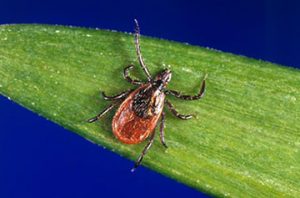Tim McDermott DVM, OSU Extension Educator, Franklin County (originally published in Farm and Dairy)

Myth #3: It’s common to believe that ticks such as this deer tick are only present during spring or summer.
I remember one day back when I was in private practice when a client brought in their dog for their examination and vaccinations and when he set his pup up on the examination table I noticed that the dog’s entire top half of his fur was slicked back. When I asked about this the client stated that he noticed ticks on the dog, so he covered him with motor oil to drown them out. I have also had clients tell me they put cigarettes out on ticks to burn them off or use kerosene to drown them off. Hopefully, they never use both of those “treatments” at the same time!
Veterinarians have a long history of dealing with the various pests that affect both companion animals and livestock. Mosquitos, flies, fleas, lice, mites, and ticks have caused severe illness as well as major economic loss for over one hundred years of animal care history. Over that time we have heard of some odd treatment protocols, homemade recipes, and unusual methods that are based more on myth than reality. The reality is that ticks and tick-borne diseases are expanding rapidly in Ohio and we do not have matching public health outreach to educate on the risks that these new ticks bring with them as well as to dispel the myths that are out there regarding prevention of tick-vectored disease. Here are some common myths regarding ticks and tick-vectored disease.
Myth #1 – “Ticks are only present in the woods.” This is a very common myth that I hear frequently. While it is true that some species of ticks such as Blacklegged tick or Lone Star tick prefer a wooded habitat, some tick species such as the American Dog tick and Gulf Coast tick can tolerate a more open habitat such as a pasture, meadow, or backyard lawn. I recently read an article where they had discovered that there were ticks in the grasses that are right up next to the beach! Make sure you realize you can encounter a tick in about any habitat.
Myth #2 – “Ticks need to be attached for a whole day to transmit disease.” This is a recommendation based on CDC research regarding Lyme disease from Blacklegged (Deer) ticks. We are now seeing some new research regarding different transmission times depending on what the pathogen is, (bacteria, virus) what life stage the tick is, (larval, nymphal, adult) as well as what disease we are concerned about. For example it is suspected that Rocky Mountain Spotted Fever has a different transmission after attachment timeframe that Lyme disease would have.
Myth #3 – “Ticks are only active in the summer.” Many ticks have multi-year life cycles to complete their growth. While the warmer weather of late spring through summer has an increased amount of tick activity, ticks can be active all 12 months of the year. How many times have we seen a period of warm weather in the winter or fall? Ohio weather is anything but predictable! Make sure you realize that you could potentially encounter a tick at any time of the year.
To keep yourself, your family and your animals tick safe this year make sure to develop a personal and family protection plan that includes protective clothing, tick checks, pet protection, proper removal methods as well as knowledge of where, when, and how you can encounter ticks and tick-vectored disease.
